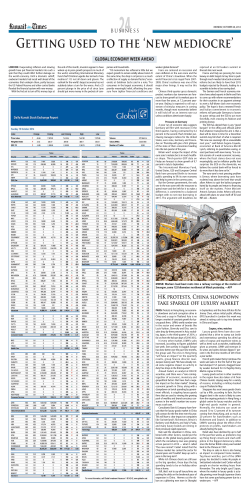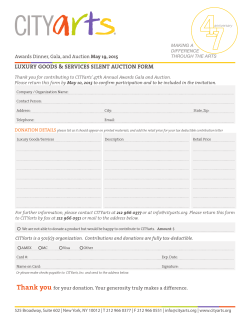
View/Open - DBS eSource
Neuromarketing Fundamentals and insights for advantageous advertising in a luxury watch context Katinka Hengsberg (10043270) - Master of Science in Marketing ABSTRACT RESEARCH METHODOLOGY DISCUSSION Advertising effectiveness has received attention from academic researchers in the neuromarketing field. However, the emerging character of the discipline implicates that research has been limited and many key areas remain insufficiently explored. Possible applications of neuromarketing techniques to generate data whose analysis results may enable practitioners in the luxury watch industry to create more effective advertisings and drive purchasing behaviour represents one such critical area that remains underdeveloped. This dissertation examines the potential of neuromarketing techniques to inform the effectiveness of luxury watch advertising. Research findings indicate that that luxury watch consumer’s perceived advertising effectiveness varies in regard to different exposure phases but unveils an overall scope for improvement. Thus, employing neuromarketing techniques and particularly fMRI to inform advertising effectiveness is both viable and beneficial for the luxury watch industry but limitations are present at the current point in time. Three uninvestigated effects of critical advertisement functions deserve acknowledgement and further exploration by neuroscientists. In order to build a more cohesive understanding of a potential neuromarketing practice in the luxury watch industry, possible applications of neuromarketing techniques to inform the various components or stages of advertising effectiveness are determined and contrasted with areas for amendment and improvement that luxury watch advertisements exhibit. In this regard, the researcher unveils various findings that have not been addressed in previous academic literature. Applicability of neuromarketing techniques in the luxury watch industry Neuromarketing techniques have the potential to complement traditional qualitative market research in the luxury watch industry by revealing additional variance which consumers cannot express explicitly and therefore cannot be obtained through traditional interviewing techniques. In this regard, a multimodal approach (triangulation) increases the certainty to trace a reaction back to a certain stimulus and accommodates disadvantages and advantages that individual methods incorporate. CONCLUSIONS The outcome of this endeavour is the presentation of several conceptual and contextual insights into the applicability of neuromarketing techniques to inform the effectiveness of luxury watch advertisements which are hoped to provide a point of reference for future research pertinent to academics and practitioners alike. INTRODUCTION Methods and insights from the field of neuroscience have received much interest and attention in the field of marketing and consumer research from academics and practitioners alike which fostered the emergence of a new discipline composed of both elements, firmly known as neuromarketing. As the discipline of neuromarketing continues to evolve, its methods are becoming increasingly important to deliver meaningful data to effectively create targeted advertising campaigns and influence purchasing behaviour. Likewise, luxury watch brands, seek to create targetgroup specific advertisements emphasising facets of luxury that refer to exclusivity, premium quality and aesthetic aspects. This implies the importance for luxury watch brands to establish a relationship with its customers by innovative experience design as well as the generation of brand-specific associations in order to encourage purchase (Tungate, 2009, pp. 56-58). The recall of these memory associations also plays an important role in the burgeoning field of neuroscience research. Relevant brain areas for the recall are wellknown and a before/after comparison of data allows to determine a brand’s potential to induce a re-evaluation of a product through a previously shown advertisement (Perrachione and Perrachione, 2008, pp. 309-310). Neuromarketing literature evolved addressing individual advertising relevant problems with methods and insights from brain research without basing the research on an underlying framework that demonstrates effectiveness on this subject. This dissertation seeks to add to the currently existing literature in academia. It takes secondary literature findings into account and strives to build on this existing knowledge by conducting primary research. The study hereby presented attempts to answer the following research question: “Do neuromarketing techniques have the potential to inform the effectiveness of luxury watch advertising in Cologne?” The following research objectives were developed from the research question in order to add an element of precision, whereby objectives 2-5 are based on the P/E/M model of advertising effectiveness: 1) To investigate neuromarketing techniques as an alternative research method tool. 2) To investigate the potential added value of neuromarketing techniques in framing consumer perceptions of advertisements. 3) To ascertain if neuroscientifically tested advertisements can enhance sensory and social experience. 4) To examine the role of neuromarketing techniques in creating advertisement related brand equity. 5) To investigate luxury watch consumers’ perceived effectiveness of luxury watch advertisings. RESULTS Neuromarketing techniques as an alternative research method tool Qualitative primary research indicated that neuromarketing techniques are fundamentally used to generate an additional marker for human behaviour, more precisely, to have access to consumers’ reactions without the filter of a conscious response which cannot be achieved by explicit questioning. The main shortcomings symbolise the high cost to employ the methods and limitations of the individual technique themselves. Neuromarketing is currently used as a qualitative approach to market research which supplements traditional research methods. Neuromarketing techniques applied to the P/E/M model of advertising effectiveness The following table combines qualitative and quantitative data analysis results, whereby quantitative data was placed in a qualitative context to facilitate comparability. It illustrates researched opportunities and capacities of neuromarketing techniques to inform exposure stages of luxury watch advertisements based on consumers’ perceived effectiveness. Framing perception of luxury watch advertisements Anticipation signals are associated with certain brain activity patterns which can be used as further marker in addition to explicit questioning. Thus, neuromarketing methods can deliver insights that help to maximise practitioners’ success in creating a sense of anticipation of a certain luxury watch experience. A neuroscientific approach, and particularly fMRI, are beneficial to the luxury watch industry in order to investigate which anticipations or reactions a luxury watch advertisement (signal in the brain) triggers. Enhancing the luxury watch advertisement experience Visual luxury watch advertisements are most likely to provide customers with an enhanced sensory experience. Neuromarketing techniques can be employed to design such advertisements or the frame or the advertisement in a way that it most effectively influences luxury watch consumers’ experiences. Utilising neuromarketing techniques in regard to social enhancement does not benefit practitioners in luxury watch industry at the current point in time since knowledge about measures for trust, has not been applied in a marketing/brand context. Luxury watch advertisements to organise memory Based on brain activation patterns, neuromarketing techniques can be employed to design a luxury watch advertisement better or differently whereby a differentiation between a general advertising recall and a brand related recall is redundant. It is currently not possible to measure which emotions a consumer is experiencing while being confronted with a luxury watch advertisement, only positive and negative arousal. Even though neuromarketing techniques cannot reliably identify emotions based on brain activity patterns, the techniques can be employed to generate data beneficial to create advertisement related brand equity. REFERENCES Perrachione, T. K. and Perrachione, J. R. (2008) ‘Brains and brands: Developing mutually informative research in neuroscience and marketing’, Journal of Consumer Behaviour, 7 (4/5), pp. 303-318. Business Source Complete, EBSCOhost [Online]. (Accessed: 05 October 2014). Saunders, M., Lewis, P. and Thornhhill, A. (2012) Research Methods for Business Students. 6th edn. Harlow: Pearson Education Limited. Tungate, M. (2009) Luxury World: The Past, Present and Future of Luxury Brands. 1st edn. London: Kogan Page.
© Copyright 2025










